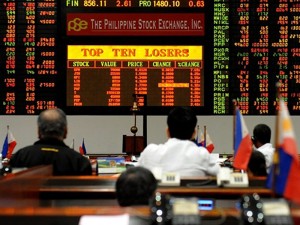
MANILA, Philippines—The local stock index hit a new record Tuesday as yield-seeking investors loaded up on blue chips, anticipating good corporate earnings in a low-interest rate environment this 2012.
The main-share Philippine Stock Exchange index gained 19.48 points, or 0.43 percent, to close at a new high of 4,561.08. This exceeded the previous record close of 4,550 posted on Aug. 1, 2011.
The day’s upswing was led by the property counter, which surged by 1.17 percent.
Value turnover amounted to P6.26 billion.
There were 100 advancers against 57 decliners, while 42 stocks were unchanged.
Investors snapped up shares of PLDT, Metrobank, AGI, Ayala Corp., EDC, Philex, Globe, DMCI, ICTSI, URC, ALI, Metro Pacific Investments, BPI, RLC, Aboitiz Power, First Gen and Megaworld. PNB likewise closed higher on active trade.
On the other hand, there was profit-taking on BDO and Lepanto “A” (open only to local investors).
Bede Lovell Gomez, assistant vice president at First Metro Investment Corp., said the local market, after outperforming most regional markets in 2011, would likely perform even better this year, hitting the 5,000 mark by yearend.
Gomez said strong investor appetite was being driven by low interest rates, manageable inflation, implementation of infrastructure spending under the public-private partnership framework, a potential credit rating upgrade and bright prospects for tourism.
“Our theme for 2012 will focus on infrastructure, gaming and consumer sector,” Gomez said.
Justino Ocampo, FMIC senior vice president and head of investment banking group, said that given the expected continuing high liquidity and low interest rate environment, infrastructure financing activities would likely be the key to more corporate issuances.
“Market recognizes the country’s underinvestment in infrastructure,” Ocampo said. “The prevailing high liquidity environment resulting in low interest rates and lengthening tenors—thanks to the government’s successful debt exchange exercises in 2011—are conducive to the financing requirements of infrastructure investments.”


